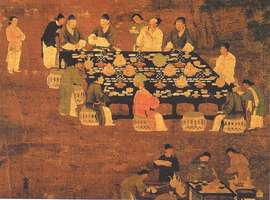Zhenian cuisine
Zhenian cuisine refers to all culinary practices, commodities and styles, both traditional and modern, observed in Zhenia. Zhenian cuisine now includes practices originating from various parts of modern-day Zhenia as well as practices found in Zhenian diasporas across the world. Along its course of development to this day, Zhenian cuisine has exchanged influence with numerous nearby cuisines, including Yinguonese cuisine.
Zhenia's diverse geography, culture, ethnic composition and history has all contributed to the diversity of practices used in Zhenian Cuisine, ultimately influencing different seasoning and cooking techniques, as well as ingredients and utensils used in the culinary process. While there are an array of different regional cuisines in the nation, four of them are considered "major cuisines" due to their reputation as being exemplary - Balhae, Bukhwa, Danguk, Seogwang respectively. Nevertheless, Zhenian food staples, including rice, noodle, tea, tofu, soybean paste and soy sauce, as well as utensils including chopsticks and rice spoons, are generally common in most regional cuisines.
History
For much of its history, Zhenian society has placed great emphasis on gastronomy under the primary philosophy that a human links himself with the world with what he eats. After the domestication of grains, starting from millet and later rice in the south and wheat in the north, Zhenians transitioned from hunting and gathering to cultivating grains in masses, greatly increasing food abundance as well as diversifying the Zhenian food spectrum. While some semi-nomadic tribes in northern Zhenia baked breads out of them, grains were primarily used to create warm noodle soups and rice. With the commoners primarily relying on grains, fruits and vegetables for nutritional supply, the wealthy and noble diversified their diet with meat and fish, both domesticating animals such as cows, dogs and lamb and hunting wild game. For the commoners, however, as they were relatively scarce, meat and fish were often shared as hot stews to maximize the quantity of people that could be fed with them.
Different regional cuisines developed in complexity after the unification of modern-day Zhenia under the Zhen dynasty; this was further accelerated as the regions under the Zhen's rule were to offer their specialties to the Emperor in Jinyang, resulting in the convergence of most regional cuisines in Jinyang. Demand to cater to the taste of the imperial court, as well as that of the aristocrats living near the imperial capital, rose, resulting in both the highest skilled culinary craftsmen and the best ingredients to be found around the imperial capital. The tradition of catering to the tastes of the noble, as well as the resultant convergence of the best ingredients and skilled culinary craftsmen in Zhenia near the imperial capital, continued on with varying forms since the Zhen dynasty until the end of imperial Zhenia, regardless of the dynasty that ruled the nation. Later during the Zhen dynasty, methods to preserve food for military campaigns and to fend off against famines were developed as well, including the practice of roasting and drying grain, drying and seasoning meat into jerky, and consuming dry, hard bread in case noodles or rice were unavailable.
Foreign contact during later years significantly influenced regional cuisines found in Zhenia. Trade routes to the west exposed much of Zhenia to western ingredients, spices and foods, including flat bread inspired by Abayadi nans, while spices from Southeast and South Tarsis began to add spicy flavors to the cuisines of southern and eastern Zhenia. It is speculated that Abayadi traders in the 8th century introduced various spices to modern-day Balhae Province, influencing the generally spicy tastes of Balhae cuisine today. The Balakhaat and Kharlin kingdoms that were established in both Hundred States Eras introduced seasoned meat and an array of dairy products, which were smoothly integrated into the cuisines of northern and central Zhenia, while the Kharlin Empire further proliferated the usage of various dairy products and animal intestines in Zhenian cuisine - it is said that sundae, or Zhenian sausage, originated during the early stages of the Kharlin Empire, when Kharlin chefs stuffed sweet noodles inside intestine leftovers as food. Sea-faring peoples to the east of the Danguk Peninsula proliferated sashimi culture, particularly in areas where live fish were abundant.
While luxurious culinary traditions continued in the mainland during the Zhu and Greater Wu dynasties, the Shindan dynasty saw a new turn in Zhenian culinary history, as it established colonies in western Veharia and across the Hanmaric Ocean. Many staple crops and spices native to Veharia, including sweet potatoes, corn, potatoes and mint, were brought back to Zhenia, while further trade in Hanmaric islands resulted in the introduction of many subtropical fruits, including various types of citrus and calamansis. It is also said that chili pepper, now a key ingredient in the spicy nature of Danguk cuisine, was brought to the Danguk Peninsula from Zhenian traders in modern-day Oya'in and were proliferated into mainland Zhenia later on. The increase in ingredient diversity was reflected into the colonial offerings to the King of Shindan, evident by records of royal banquets depicting the usage of subtropical fruits from modern-day Zihara Luhan as alcoholic snacks at the time. It was also during the Shindan dynasty that records regarding all royal culinary traditions in the Danguk Peninsula that still exist to this day were written, serving both as fundamentals of luxurious culinary styles in modern Zhenia and important figures of reference in studying such culinary traditions.
The Zhenian Civil War and the subsequent breakdown of traditional order in mainland Zhenia, as well as the abolition of the social caste system in all of Zhenia, signifying the need for change to the existing culture of catering to the tastes of aristocrats and ending the imperial house's monopoly on both the nation's best ingredients and skilled culinary craftsmen. With an increasing demand for quality cuisine from the newly-rich industrialists and merchants, high-end Zhenian cuisine took a new turn to cater to the newly-rich, resulting in the opening of many luxurious restaurants serving cuisine formerly served to the imperial house and its closest aristocrats. Many Zhenian gastrnomes during the late 19th century, including Han Meiyoon, are credited for the standardization of luxurious Zhenian cuisine, particularly in its ingredients, procedures and culinary techniques, emphasizing the 'harmony of the five tastes' (sweetness, saltiness, sourness, bitterness and spiciness) in the selection of ingredients and the cooking process, as well as appropriately extracting the flavor of each ingredient in each dish.
Modern Zhenian cuisine developed further with the influx of western culinary styles amid Zhenian interactions with Auroran nations, with the proliferation of western culinary styles beginning from port cities and making their way further inland. Some Auroran culinary styles took new turns in Zhenia, seen on cases such as the Auroran port cutlets being adapted into Zhenia as Zhenian port cutlets. Zhenian cuisine in general has seen further simplification and fusion since the later half of the 20th century, amid the adaptation of fast-paced modern lifestyles among the majority of the Zhenian populace.
Regional cuisines
Staple foods
Rice
Wheat
Ingredients
Vegetables
Meat and fish
Dairy products
Soybean-based products
An array of soybean-based products are used within Zhenian cuisine.
Seasoning and herbs
Drinks
Non-alcoholic beverages
Alcoholic beverages
Zhenian cuisine outside Zhenia
Meal routine and structure
Breakfast
Due to the agriculture-based social structure throughout much of its history, most tracts of classical Zhenian cuisine have a relatively high emphasis on breakfast as the first meal of the day, although not receiving as much attention as dinner. Classically, breakfast in Zhenian cuisine is normally centered around either hot noodle soups and accompanying side dishes, or a set consisting of a bowl of steamed rice, soup and accompanying side dishes. The bowl of steamed rice normally consists of rice but can be partially substituted and augmented with other grains, including beans, millet and barley, while commonly-used accompanying soups include seaweed soup, soybean paste-based soup, portions of hot spicy meat stew and bean sprout soups.
A distinct characteristic found in most Zhenian breakfasts as opposed to other meals of the day is that spiciness is restrained to reduce unnecessary stimulus to the body - in practice, it is a widely-respected rule in classical Zhenian breakfasts that no more than two side dishes, or one if either the noodle soup or the rice-accompanying soup is spicy, can be spicy at the same time. Furthermore, in respect of Zhenia's traditional philosophy of preventing the over-arousing of the body since the beginning of the day, side dishes in Zhenian breakfasts in principle are not recommended to be too arousing or strong in flavor. While drinks are generally not recommended during the breakfast meal, a cup of most non-alcoholic beverages, including water and soy milk, are broadly accepted as a pre-meal measure.
Breakfast meals in the weekends and holidays can be more plentiful, with an additional central dish in the middle of the table for sharing among those having the meal. Common 'central dishes' used in breakfast meals include steamed pork, seasoned and grilled fish and braused beef ribeye. Like side dishes, these dishes served in breakfast meals are normally not as arousing or strong in flavor as their counterparts in lunch and dinner.
Lunch

Lunch in most tracts of Zhenian cuisine is regarded as a relatively light meal in the middle of the day. The Zhenian term for lunch (점심/點心) is literally translated as 'a dot in the mind', indicating the relatively minimalist Zhenian philosophy in mid-day meals. Lunch is relatively lighter than other meals in most tracts of Zhenian cuisine, owing to the agricultural traditions of having relatively light, but high-calorie meals in the middle of the day and compensating by reinforcing breakfast and dinner meals. Normally provided at work or in school, lunch in Zhenian cuisine normally consists of one or two courses at most, usually with a single bowl of the main entrée, with geographic and cultural variations, and an accompanying selection of side dishes. Unlike breakfast, lunch meals are subject to less rigid conventions regarding the balance of tastes as well as the relationship between the human and the meal.
Traditional lunches served in the imperial court and its closest aristocrats tend to be more complex and plentiful both in process and quantity, usually consisting of a number of central dishes divided into a number of courses. Some of the most lavish lunches served directly to the emperor are said to resemble the dinners of aristocrats in its plentifulness.
Dinner
Formally, Zhenian dinner is often the most plentiful and lavish meal of the three meals in Zhenian cuisine, complete with several courses, especially in restaurants, while the course can be simplified at home.




